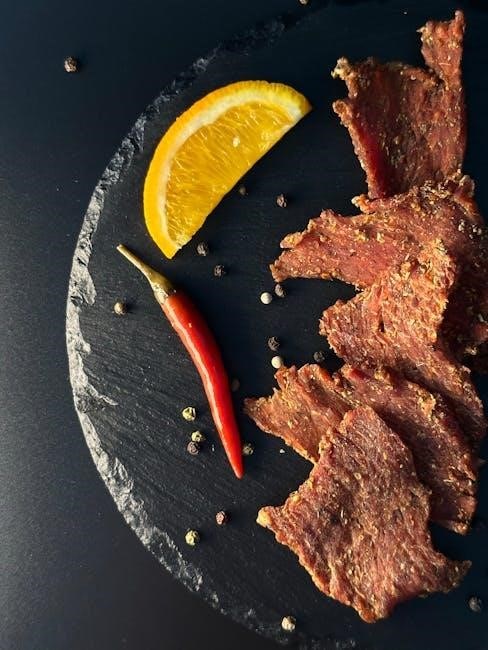high country jerky seasoning instructions
High Country Jerky Seasoning offers a reliable way to craft delicious, high-quality jerky at home. With step-by-step guides and expert tips, it ensures flavorful results every time.

Overview of High Country Jerky Seasoning
High Country Jerky Seasoning is a popular choice for outdoor enthusiasts and home jerky makers, offering a blend of high-quality ingredients like salt, sugar, spices, garlic, and cure. The seasoning is designed to enhance flavor while ensuring proper preservation. Each kit includes measured packets of cure and seasoning, making it easy to follow step-by-step instructions. The cure plays a crucial role in preventing spoilage and foodborne illness, while the spices add a rich, savory taste. With convenient packaging and bulk options available, High Country Jerky Seasoning is ideal for both small batches and large-scale jerky production. Its long shelf life ensures freshness, and the individual batch-sized units maintain flavor consistency. Whether for beef, venison, or other meats, High Country Jerky Seasoning provides a reliable way to achieve delicious homemade jerky.
Importance of Following Instructions
Following the instructions for High Country Jerky Seasoning is crucial for achieving the best results. Proper measurement of cure and seasoning ensures the jerky is safe to eat and flavorful. Overuse of cure can lead to overly salty jerky, while underuse may compromise preservation. The recommended marinating and curing times are essential for even flavor distribution and food safety. Deviating from instructions can result in jerky that is too dry, tough, or unsafe to consume. Adhering to the guidelines helps maintain the jerky’s quality and prevents common issues like spoilage or uneven seasoning. By sticking to the step-by-step process, you ensure a consistent and delicious homemade jerky experience every time.

Key Ingredients in High Country Jerky Seasoning
The seasoning typically includes salt, sugar, spices, garlic, and cure for preservation. These ingredients ensure flavor balance and prevent spoilage, making homemade jerky safe and delicious.
Salt, Sugar, and Spices
Salt, sugar, and spices are fundamental components in High Country Jerky Seasoning. Salt enhances flavor and acts as a natural preservative, while sugar adds a touch of sweetness and aids in browning. Spices like garlic, paprika, and onion powder provide depth and complexity to the jerky. These ingredients work together to create a balanced flavor profile that complements the natural taste of the meat. Proper proportions of these components ensure the jerky is neither too salty nor overly sweet, while also preventing spoilage during the drying process. The combination of these elements is essential for achieving the signature taste of High Country Jerky Seasoning, making it a favorite among homemade jerky enthusiasts.
Role of Cure in Preservation
The cure in High Country Jerky Seasoning plays a crucial role in preservation by preventing bacterial growth and ensuring food safety. It contains key ingredients like sodium nitrite, which inhibits the growth of harmful pathogens, such as botulism, during the curing process. The cure also enhances the jerky’s texture and flavor, contributing to its signature taste. Proper use of the cure is essential to avoid over-salting, which can make the jerky unpalatable. The cure penetrates the meat evenly over time, typically requiring 24 hours for whole muscle meats and 12 hours for ground meats. This step is vital for maintaining quality and extending the jerky’s shelf life, ensuring it remains safe to eat and delicious for a longer period.

Storage and Handling Tips
Proper storage in airtight containers and refrigeration ensures jerky remains fresh. Pat dry before storing to prevent grease buildup. Keep away from direct sunlight for best results.
Proper Storage Conditions
Store jerky in airtight containers to maintain freshness and prevent moisture absorption. Keep in a cool, dry place or refrigerate to preserve flavor and texture. Pat jerky dry before storing to remove excess grease, ensuring it stays dry and avoids spoilage. For homemade jerky, refrigeration is essential due to the absence of preservatives. Freezing is ideal for long-term storage, while refrigeration suffices for short-term use. Always allow jerky to cool completely before storing to prevent condensation. Proper storage conditions help retain the jerky’s quality and prevent bacterial growth. Following these guidelines ensures your jerky remains fresh, flavorful, and safe to eat for an extended period.
Shelf Life and Freshness
Homemade jerky made with High Country Seasoning typically lasts up to 2 weeks when stored properly in an airtight container at room temperature. For optimal freshness, keep it refrigerated, extending shelf life to about 3-4 weeks. Freezing is recommended for longer storage, preserving jerky for up to 6 months without losing flavor or texture. Always ensure jerky is completely dry before storing, as excess moisture can lead to spoilage. Proper storage conditions are crucial to maintaining freshness and preventing bacterial growth. Regularly check stored jerky for any signs of spoilage, such as off smells or mold, and discard if necessary. By following these guidelines, you can enjoy your homemade jerky for a longer period while retaining its quality and flavor.

Preparation Process for Making Jerky
Start by selecting lean meat, trimming excess fat, and slicing it thinly. Mix the High Country Seasoning evenly, ensuring all surfaces are coated for consistent flavor.
Selecting the Right Cut of Meat
Selecting the right cut of meat is crucial for making high-quality jerky. Lean cuts, such as top round or flank steak, are ideal due to their low fat content, which prevents spoilage and ensures even drying. Avoid fatty cuts, as they can lead to greasy jerky and shorter shelf life. For best results, choose meat with less than 10% fat. Trim any visible fat or connective tissue before slicing to ensure uniform seasoning absorption and drying. Freezing the meat slightly can make slicing easier and more precise, helping you achieve thin, consistent strips. Always opt for fresh, high-quality meat to maximize flavor and texture when using High Country Jerky Seasoning.
Trimming and Slicing the Meat
Proper trimming and slicing are essential for achieving tender and evenly seasoned jerky. Start by trimming all visible fat and connective tissue from the meat, as these can lead to a greasy texture and shorter shelf life. For best results, use a sharp knife to slice the meat into thin, uniform strips, ideally 1/4 inch thick. Consistent thickness ensures even drying and prevents some pieces from becoming too dry while others remain chewy. If the meat is challenging to slice evenly, consider freezing it for about 30 minutes to firm it up, making the slicing process easier and more precise. Always slice against the grain to enhance the jerky’s texture and flavor.
Mixing the Seasoning with Meat
Mixing the seasoning with meat is a crucial step in creating flavorful jerky. Start by placing the sliced meat in a non-metallic container to avoid any metallic aftertaste. Sprinkle the High Country Jerky Seasoning evenly over the meat, ensuring every piece is coated. Use your hands or a spoon to gently mix the meat and seasoning, taking care not to compact the meat excessively. This ensures the flavors penetrate deeply without making the jerky dense. For optimal results, allow the seasoned meat to marinate in the refrigerator for the recommended time, usually several hours or overnight. This step allows the seasonings to infuse into the meat, enhancing the overall taste and texture of the final product. Proper mixing and marinating are key to achieving a balanced, savory jerky.

Marinating and Curing
Marinate meat for 24 hours for whole muscle or 12 hours for ground meat. Curing ensures food safety and enhances flavor, preventing bacterial growth during drying.
Recommended Marinating Time
The recommended marinating time for High Country Jerky Seasoning varies based on the type of meat. For whole muscle cuts, marinate for 24 hours to ensure deep flavor penetration and proper curing. Ground meats typically require 12 hours, as they absorb seasonings and cure more quickly. It’s crucial to follow these guidelines to achieve the best texture and flavor. Always mix the seasoning and cure thoroughly with the meat before marinating. Store the mixture in a non-metallic container, refrigerate, and let the process work. This step is essential for both flavor development and food safety, ensuring your jerky is tender and evenly seasoned.
Curing Process for Different Meat Types
The curing process varies depending on the type of meat being used. For whole muscle cuts, such as beef or venison, the recommended curing time is 24 hours. This allows the cure to penetrate deeply and ensure even distribution of flavor and preservation. Ground meats, on the other hand, require a shorter curing time of 12 hours, as the smaller particles absorb the seasoning and cure more quickly. It’s important to mix the cure thoroughly with the meat and refrigerate during the curing process. Proper curing ensures food safety by preventing bacterial growth and enhances the jerky’s texture and flavor. Always follow the instructions provided with the High Country Jerky Seasoning for optimal results.

Cooking Methods for Jerky
Explore various cooking methods for jerky, including oven drying, smoking for enhanced flavor, and using a dehydrator for consistent results. Alternative methods like air frying are also popular.
Using an Oven for Drying
Drying jerky in an oven is a straightforward and accessible method for achieving perfectly textured results. Preheat your oven to its lowest temperature setting, typically around 150-200°F. Line the oven racks with jerky strips, ensuring they don’t overlap for even drying. Place a non-stick surface, like parchment paper, on the bottom rack to catch any drips. Dehydrate for 3-4 hours, or until the jerky reaches your desired dryness. For consistent results, use a meat thermometer to monitor internal temperatures. Avoid overcrowding the racks, as this can lead to uneven drying. Once done, let the jerky cool before storing it in an airtight container. This method is ideal for those without a dehydrator, offering a reliable way to make homemade jerky.
Smoking Jerky for Enhanced Flavor
Smoking jerky is an excellent way to infuse rich, savory flavors into your homemade jerky. For best results, use a smoker set to a low temperature of 100-150°F, allowing the meat to absorb the smoke gradually. Popular wood options like mesquite, apple, or cherry add distinct flavor profiles; Ensure the jerky strips are evenly spaced on the racks to promote consistent smoke circulation. Smoking time typically ranges from 3-6 hours, depending on the thickness of the meat and desired dryness. Keep the smoker lid closed to retain heat and smoke. After smoking, pat the jerky dry with paper towels to remove excess moisture before cooling and storing. This method enhances the jerky’s texture and flavor, making it a favorite for those who enjoy a smoky twist.
Dehydrator Settings and Tips
Using a dehydrator is a popular method for making jerky at home, offering consistent results and ease of use. Set your dehydrator to 135-155°F for optimal drying. Place jerky strips in a single layer on the trays to ensure even airflow. Dehydrate for 3-4 hours for thin strips or up to 6 hours for thicker cuts, checking periodically to avoid over-drying. To enhance flavor, you can pre-heat the dehydrator before adding the seasoned meat. Pat dry the meat thoroughly before placing it in the dehydrator to remove excess moisture. For the best texture, avoid overcrowding the trays. Once dry, let the jerky cool completely before storing. Follow these tips for perfectly dried jerky with a delicious, chewy texture and robust flavor.
Alternative Methods (Air Fryer, etc.)
For those without a dehydrator or smoker, alternative methods like using an air fryer or pellet grill can produce delicious jerky. Preheat the air fryer to 135-150°F and place jerky strips in a single layer. Cook for 2-4 hours, flipping halfway, until dry and slightly flexible. Pat the meat dry before cooking to remove excess moisture. For pellet grills, set the temperature to 150-200°F and smoke for 3-5 hours, ensuring low heat for even drying. These methods offer convenience and flexibility while maintaining the rich flavor of High Country Jerky Seasoning. Always monitor the jerky to prevent overcooking and store it properly after cooling for the best texture and freshness.

Safety Guidelines
Adhering to food safety guidelines is crucial when making jerky. Proper handling, storage, and hygiene practices ensure safe consumption. Always follow instructions to prevent contamination and foodborne issues.
Food Safety Precautions
When preparing jerky using High Country Jerky Seasoning, it’s essential to follow proper food safety guidelines to ensure a safe and enjoyable product. Always handle raw meat safely, keeping it separate from cooked or ready-to-eat foods to prevent cross-contamination. Use clean utensils and cutting boards, and wash your hands thoroughly before and after handling the meat.
Store the seasoned meat in a sealed, non-metallic container to avoid metallic flavors and contamination. Refrigerate at 38°F (3°C) or below during the marinating process. After cooking, pat the jerky dry with paper towels to remove excess grease, which can attract bacteria and reduce shelf life.
Never skip the curing step, as it prevents bacterial growth and ensures food safety. Follow the recommended curing times (24 hours for whole muscle, 12 hours for ground meat) to avoid under-curing, which can lead to spoilage. Store the finished jerky in airtight containers and keep it refrigerated or frozen to maintain freshness and prevent contamination.
Avoiding Over-Salting
Avoiding over-salting is crucial when using High Country Jerky Seasoning to ensure a balanced flavor. Start by following the recommended proportions of seasoning to meat, as specified in the instructions. Using too much cure or seasoning can result in jerky that’s overly salty and unpalatable.
Measure the seasoning and cure accurately, using a kitchen scale or measuring spoons to avoid over-seasoning. Mix the seasoning evenly into the meat to distribute the flavors consistently. If you’re marinating, refrigerate the mixture to allow the flavors to meld without over-concentrating the salt.
After curing, rinse the meat under cold water to remove excess salt before cooking. Pat dry thoroughly to prevent moisture from intensifying the saltiness during cooking. Taste the jerky before final storage to adjust seasoning if needed.

Tips for Customizing Jerky
Add personal touches like herbs, spices, or honey to High Country Jerky Seasoning for unique flavors. Experiment with meats, from beef to venison, for diverse jerky experiences.
Adding Personal Flavor Preferences
Enhance your jerky by adding personal flavor touches to High Country Jerky Seasoning. Try incorporating herbs like thyme or rosemary for earthy notes, or spices like cayenne for heat. For sweetness, mix in honey or brown sugar. Acidic ingredients like Worcestershire sauce or vinegar can deepen the flavor profile. Experiment with garlic powder, onion powder, or smoked paprika for added depth. Consider marinating the meat in soy sauce, teriyaki, or BBQ sauce before seasoning for a unique twist. Consider adding a splash of liquid smoke for a smoky flavor or a drizzle of maple syrup for sweetness. These customizations allow you to tailor the jerky to your taste preferences while maintaining the quality of the High Country Jerky Seasoning base.
Experimenting with Different Meats
High Country Jerky Seasoning is versatile and works well with various meats, allowing you to experiment beyond traditional beef. Try venison for a lean, gamey flavor or turkey for a lighter option. Chicken and pork can also be used, offering a tender and juicy texture. For seafood lovers, salmon or trout make excellent jerky with a smoky, savory taste. When using game meats like elk or deer, ensure proper trimming of fat for optimal drying. Poultry and fish require shorter marinating times to avoid over-seasoning. Ground meats like pork or turkey can be mixed with the seasoning for snack sticks. This flexibility lets you explore diverse flavors while maintaining the seasoning’s quality and reliability. Experimenting with different meats keeps your jerky-making process exciting and tailored to your preferences.

Troubleshooting Common Issues
Common issues like jerky being too dry or salty can be resolved by adjusting curing times and salt levels. Ensure proper slicing thickness for consistent results.
Why Jerky Might Be Too Dry
Jerky can become too dry if overcooked or exposed to high heat for too long. Over-drying strips the meat of its natural moisture, resulting in a brittle texture. Ensure slices are uniform thickness to prevent uneven drying. Always monitor jerky during cooking, especially when using ovens or dehydrators. Proper marinating and curing times are crucial, as over-curing can also lead to dryness. Pat dry jerky after cooking to remove excess moisture before storing. Avoid over-salting, as it can accelerate moisture loss. For best results, follow High Country Jerky Seasoning instructions precisely and use a meat thermometer to maintain optimal drying temperatures. Adjust cooking times for different meat types to achieve the perfect texture. Proper storage in airtight containers also helps maintain freshness and prevent further drying.
Fixing Overly Salty Jerky
If your jerky turns out overly salty, there are steps to balance the flavor. First, rinse the jerky strips under cold water to remove excess salt, then pat them dry with paper towels. Adding a small amount of sweetness, like honey or brown sugar, can counteract the saltiness. Alternatively, marinating the jerky in a mixture of olive oil and vinegar can help neutralize the salt. For severe cases, rehydrating the jerky slightly in a flavorful liquid, such as broth or teriyaki sauce, can restore balance. Always follow High Country Jerky Seasoning instructions carefully to avoid over-salting in future batches. Adjusting cure amounts or marinating times can prevent this issue altogether. Proper storage in airtight containers will also maintain freshness and flavor balance;
Making jerky with High Country Jerky Seasoning is a straightforward process that yields delicious and high-quality results. By following the step-by-step instructions, you can ensure perfectly seasoned jerky every time. The key to success lies in proper preparation, marinating, and cooking techniques. Whether you’re using an oven, smoker, or dehydrator, the seasoning blend enhances the natural flavor of the meat while preserving it safely. Experiment with different meats and flavors to create unique jerky varieties. Remember to store your jerky properly to maintain freshness and safety. With High Country Jerky Seasoning, you can enjoy homemade jerky that rivals store-bought options. Happy cooking and enjoy the fruits of your labor!
